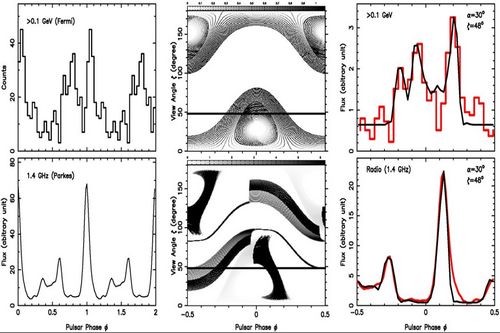
A research team led by National Space Science Center, Chinese Academy of sciences (NSSC) and Peking University has successfully simulated new patterns of pulsed gamma-ray emission from newly discovered millisecond pulsars (MSPs) using the sensitive Fermi data, which sheds light on studies of the emission region and its mechanism. The newly discovered and specific patterns of radio and gamma-ray emission from PSR J0101-6422 challenge the popular pulsar models, e.g. outer gap and two-pole caustic models.
Using the three dimensional annular gap model, the research team has jointly simulated radio and gamma-ray light curves for three representative MSPs (PSR J0034-0534, PSR J0101-6422 and PSR J0437-4715) with distinct radio phase lags and present the best simulated results for these MSPs, particularly for PSR J0101-6422 with complex radio and gamma-ray pulse profiles, and for PSR J0437-4715 with a radio interpulse.
It is also found that both the gamma-ray and radio emission originate from the annular gap region located in only one magnetic pole, and the radio emission region is not primarily lower than the gamma-ray region in most cases. In addition, the annular gap model with a small magnetic inclination angle instead of "orthogonal rotator" can account for MSPs' radio interpulse with a large phase separation from the main pulse.
The annular gap model is a self-consistent model not only for young pulsars but also MSPs, and multi-wavelength light curves can be fundamentally explained by this model.
About Pulsar:
Pulsar is a highly magnetic, rotating neutron star. One of the prominent properties of pulsar, differentiating it from other fixed stars in the Galaxy is that pulsar emits regularly a beam of electromagnetic radiation that is like a light tower. Such radiation can only be observed when the pulsed emission is pointing towards the Earth. Each pulsar has a stable spin period ranging roughly from milliseconds to seconds, resulting in a very precise interval between pulses.
Jocelyn Bell Burnell and Antony Hewish discovered the first pulsar with a pulse period of about 1.33 seconds in 1967. They made great efforts to give convincing explanations for such unusual emission, yet in vain. After eliminating all the possibilities, Burnell noted that “we did not really believe that we had picked up signals from another civilization, but obviously the idea had crossed our minds”, which forms the reason why the first discovered pulsar was named LGM-1, for "Little Green Men", a playful name for intelligent alien beings of extraterrestrial origin.

PSR J0101-6422 (Image by NSSC)

86-10-68597521 (day)
86-10-68597289 (night)

86-10-68511095 (day)
86-10-68512458 (night)

cas_en@cas.cn

52 Sanlihe Rd., Xicheng District,
Beijing, China (100864)

